All About St. Gaudens Gold Coins
INTRODUCTION
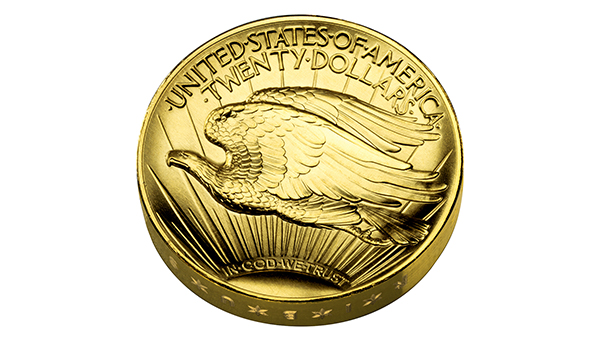
Saint-Gaudens gold coins, also known as Saint-Gaudens double eagles, hold immense rarity and value in the world of coin collecting. Designed by prominent sculptor Augustus Saint-Gaudens and commissioned by President Theodore Roosevelt, these gold coins are highly sought after by collectors and investors worldwide.
What sets the Saint-Gaudens gold coins apart is their exquisite design and the fact that they contain a full ounce of gold. With a face value of $20, these coins were initially minted from 1907 until 1933. The obverse design features Lady Liberty walking confidently with an olive branch in one hand and a torch held high in the other.
The rarity and value of Saint-Gaudens gold coins are greatly influenced by the demand from collectors. Due to their limited mintage and historical significance, these coins command significant premiums in the market. The gold content of the coins also contributes to their value, especially when the price of gold is high.
It is worth noting that due to an executive order by President Franklin D. Roosevelt in 1933, a vast majority of Saint-Gaudens gold coins were melted down. Today, these rare coins are mostly found in private hands, as well as in the vaults of European banks.
HISTORY AND SIGNIFICANCE
The Saint-Gaudens gold coins (St Gaudens gold coins) have a fascinating history and hold great significance in the world of coin collecting. Designed by the renowned sculptor Augustus Saint-Gaudens and commissioned by President Theodore Roosevelt, these coins were minted from 1907 to 1933. The stunning design of these coins, featuring Lady Liberty walking confidently with a torch and an olive branch, is considered one of the most beautiful in American coinage. The creation of these coins marked a turning point in American coin design, breaking away from the traditional portrayals of Lady Liberty and introducing a more artistic and dynamic approach. Today, these coins are highly sought after by collectors and investors for their rarity, historical significance, and the value of their gold content.
Augustus Saint-Gaudens
Augustus Saint-Gaudens was a prominent sculptor known for his exceptional artistic talent during the late 19th and early 20th centuries. His legacy includes the creation of the famous Saint-Gaudens Gold Double Eagle, a masterpiece in American coinage.
Saint-Gaudens had a close relationship with President Theodore Roosevelt, who admired his work and sought to reform the design of American coins. With Roosevelt's endorsement, Saint-Gaudens was appointed as the Chief Engraver of the United States Mint in 1905.
The result of their collaboration was the Saint-Gaudens Gold Double Eagle, a $20 gold piece designed in high relief featuring an exquisite rendering of Lady Liberty holding an olive branch on one side, and an eagle in flight on the other. The coin was produced from 1907 to 1933 at the Philadelphia, Denver, and San Francisco mints.
Augustus Saint-Gaudens' design transformed American coinage, bringing an artistic flair that had not been seen before. His attention to detail and focus on naturalistic elements made the Saint-Gaudens Gold Double Eagle one of the most beautiful coins ever produced. Today, it remains highly coveted among collectors and investors for its historical significance and intrinsic value.
Theodore Roosevelt
Theodore Roosevelt, the charismatic and influential U.S. president, played a pivotal role in the creation of the iconic Saint-Gaudens Gold Coins. Roosevelt shared a deep admiration for the artistic talents of Augustus Saint-Gaudens, a prominent sculptor known for his ability to bring life and depth to his works.
Recognizing the opportunity to reform the design of American coins, Roosevelt wanted Saint-Gaudens to apply his artistic genius to the creation of a new series of U.S. coin designs. Inspired by the designs used in ancient Greece, they envisioned producing coins with high relief design that would elevate American coinage to a new level of artistry and beauty.
Roosevelt's enthusiasm for this project was so great that he famously referred to it as his "pet crime," emphasizing his passion and determination to bring about this artistic revolution in American coin design. With the support of the president, Saint-Gaudens was appointed as the Chief Engraver of the United States Mint in 1905, a position that allowed him to bring his visionary designs to life.
Roosevelt's collaboration with Saint-Gaudens not only transformed the aesthetics of American coins but also left an enduring legacy. The Saint-Gaudens Gold Coins, including the iconic Saint-Gaudens Double Eagle, have become cherished collectibles, reflecting the artistic vision and dedication of both Roosevelt and Saint-Gaudens.
Charles E. Barber
During the era of the Saint-Gaudens gold coins, another prominent figure played a significant role in their production and design - Charles E. Barber. Chief engraver at the U.S. Mint, Barber was responsible for overseeing the minting process and the creation of the coins.
Barber's influence on the Saint-Gaudens gold coins can be seen in the partnership and conflicts he had with Augustus Saint-Gaudens. While Saint-Gaudens was responsible for the initial design concepts, Barber was tasked with translating those ideas into practical coinage. This collaboration between the two artists resulted in the creation of the iconic double eagle coin.
However, their artistic differences and conflicting visions occasionally led to tension. Barber preferred a more traditional and conservative design approach, which clashed with Saint-Gaudens' desire to elevate American coinage to a new level of artistry. Despite these conflicts, Barber's expertise and craftsmanship were invaluable in bringing Saint-Gaudens' designs to life as coinage, as his own low relief version allowed for the production of the double eagles on a large-scale basis.
Thanks to the collaboration between Augustus Saint-Gaudens and Charles E. Barber, the Saint-Gaudens gold coins became a shining example of American coin design. Their artistic and historical significance continues to captivate collectors and enthusiasts alike.
DESIGN OF THE SAINT-GAUDENS GOLD DOUBLE EAGLE
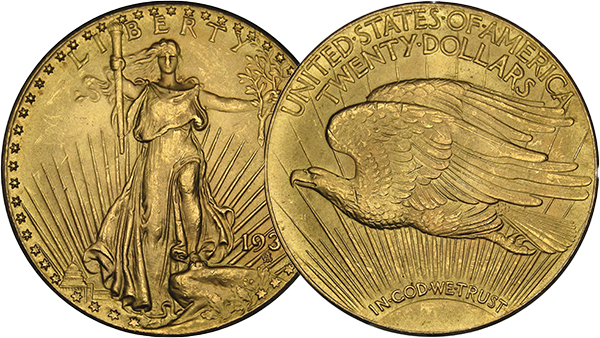
The design of the Saint-Gaudens Gold Double Eagle is a remarkable testament to the artistic vision and skill of its creator. This iconic gold coin is cherished by collectors and investors alike for its exquisite beauty and rich symbolism.
On the obverse side of the coin, Saint-Gaudens has depicted a majestic figure of Lady Liberty striding forward. She holds a torch in one hand and an olive branch in the other. The torch symbolizes enlightenment and progress, while the olive branch represents peace. The intricate detailing and lifelike representation of Lady Liberty truly elevate the design to a level of artistry rarely seen in American coinage.
Other notable elements on the obverse include the U.S. Capitol building, which serves as a reminder of the country's democratic values, and the stars that surround Lady Liberty, representing the states of the nation.
The reverse side of the coin features an Eagle in Flight design, showing a powerful eagle soaring above the sun. This design symbolizes the freedom and strength of the United States. The combination of the eagle and the sun lends a sense of power and vitality to the coin.
The design of the Saint-Gaudens Gold Double Eagle is a true masterpiece, showcasing the extraordinary talent of Augustus Saint-Gaudens. It's rich symbolism and intricate details make it a highly sought-after coin known for its beauty and artistry.
Reverse Design Of The Coin
The reverse design of the Saint-Gaudens Gold Double Eagle coin showcases the magnificent Eagle in Flight. This design captures the essence of American freedom and strength. The eagle is depicted in full flight, with its wings spread wide, exuding power and grace. The sun is also featured in the design, adding a vibrant backdrop to the image of the eagle.
The reverse design carries significant symbolism. The soaring eagle represents the United States' enduring spirit and ability to rise above any challenge. As a national symbol, it embodies the American ideals of freedom, courage, and resilience.
The attention to detail in the reverse design is remarkable. Each feather on the eagle's wings and tail is meticulously rendered, enhancing the overall beauty and grandeur of the coin. The combination of the eagle and the sun in the design sends a powerful message of optimism and confidence in the future of the nation.
The production of the Saint-Gaudens Gold Double Eagle coins took place at various branch mints, including the San Francisco Mint. These coins were widely distributed across the United States, fueling the demand for gold coinage during the early 20th century. Today, these coins are highly sought after by collectors and investors due to their historical significance and exquisite design.
Obverse Design Of The Coin
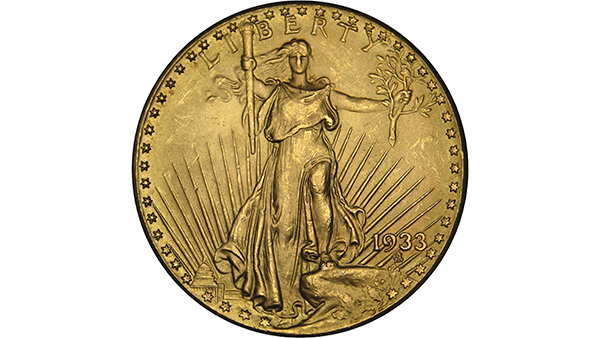
The obverse design of the Saint-Gaudens gold coin is a true masterpiece. This features a stunning depiction of Lady Liberty. She stands proudly, holding a torch in one hand and an olive branch in the other, symbolizing enlightenment and peace. The intricate attention to detail is evident in every aspect of the design, from the folds of her robe to the image of U.S. Capitol Building to her right. This iconic image is a testament to the enduring beauty and artistic excellence of American coinage. No wonder the Saint-Gaudens gold coin is highly sought after by collectors and investors alike, as it represents not only a piece of history but also a work of art.
Features of the “Eagle in Flight” Design
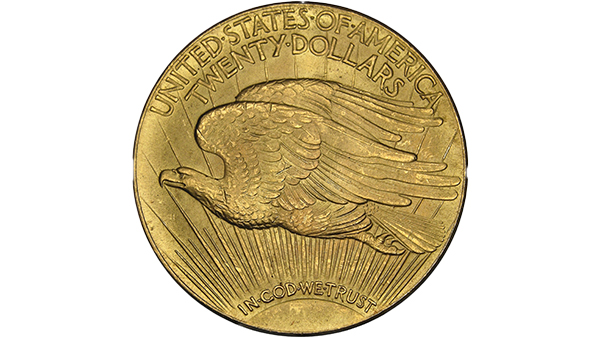
The "Eagle in Flight" design on the reverse of the Saint-Gaudens Gold Double Eagle coin is a captivating representation of American freedom and power. The design showcases an exquisite portrayal of an eagle soaring through the air, with its wings outstretched and feathers beautifully detailed.
One noteworthy aspect of this design is the depiction of the eagle traversing shining sun rays. This artistic choice infuses the coin with a sense of dynamism and energy, truly capturing the spirit of the American nation. The rays of the sun appear to radiate from behind the eagle, adding a majestic touch to the overall design.
Engraved on the reverse of the coin are the words "United States of America" and "TWENTY DOLLARS", indicating its face value. Additionally, the famous motto "IN GOD WE TRUST" can be found prominently displayed in the design. This was initially left out at President Roosevelt's request but later added after much outrage from Congress.
The "Eagle in Flight" design is not only a spectacular artistic achievement, but it also pays homage to the strength and resilience of the American people. This iconic symbol has become synonymous with American coinage and continues to inspire collectors and admirers alike.
The Symbolism Behind the Olive Branch
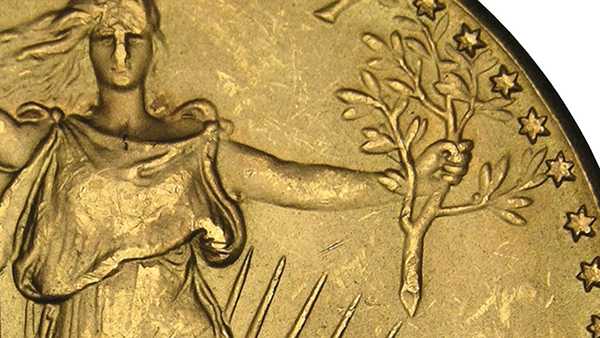
The olive branch holds significant symbolism in the design of the Saint-Gaudens Gold Double Eagle coin. The branch, held by Lady Liberty, represents peace and harmony. It serves as a powerful reminder of the United States' commitment to diplomacy and its desire for a peaceful existence.
In the overall design and historical context, the olive branch takes on even greater importance. During the early 20th century when the coin was first minted, the world was still grappling with the aftermath of World War I. The inclusion of the olive branch thus can be seen as a reflection of the nation's hope for peace and its dedication to resolving conflicts through peaceful means.
In addition to the olive branch, the coin's design features other symbolic elements. The depiction of the flying eagle represents freedom, power, and courage, embodying the essence of the American spirit. The rays of the sun, radiating from behind the eagle, symbolize enlightenment and progress. Together, these elements create a design that not only showcases the beauty of American coinage but also tells a story of hope, peace, and national pride.
PRODUCTION AND DISTRIBUTION OF ST GAUDENS GOLD COINS
The St Gaudens Gold Coins were produced and distributed during the early 20th century, specifically from 1907 to 1933. These exquisite coins were primarily struck at the United States Mint in San Francisco, with a smaller number also produced at the Philadelphia and Denver Mints.
In 1933, the last year of issue, a total of 445,500 Saint-Gaudens Double Eagle gold coins were minted, with the majority struck in San Francisco. However, due to the economic turmoil of the Great Depression and subsequent gold confiscation by the U.S. government in 1933, many of these coins were melted down, leaving only a fraction of the original mintage still in circulation today.
The availability and circulation of the St Gold Coins is very limited. While these coins were intended for general circulation, the majority of them never entered the hands of the public. Many were kept in private collections or stored in secure bank vaults, both in the United States and in European bank vaults.
It is worth noting that due to the issuance of Executive Order 6102 in 1933 by President Franklin D. Roosevelt, it became illegal for U.S. citizens to own gold coins. As a result, the ownership and distribution of St Gaudens Gold Coins faced controversy and restrictions, further contributing to their scarcity and value in the collector market.
Despite the limited availability and controversial history surrounding their ownership, the St Gaudens Gold Coins remain highly sought after by collectors and investors worldwide. With their exquisite design and historical significance, these coins continue to be cherished as a valuable piece of American coinage history.
PRODUCTION AT SAN FRANCISCO MINT
The production of St Gaudens Gold Coins at the San Francisco Mint was an integral part of the coin's history.
The minting process at the San Francisco Mint involved the use of different mintmarks to denote the mint of origin. The "S" mintmark, representing San Francisco, was stamped on these coins. This mintmark added a unique feature to the coins and also helped in tracking their origin.
Another notable aspect of the St Gaudens Gold Coins was the omission of the motto "In God We Trust" from the initial designs. Roosevelt had specifically ordered for it to be left out, as he feared the coins might be used in criminal activities. However, that was met with public outcry, and Congress ordered the motto to reappear. The motto was added to the coin's reverse design in 1908.
In 1909, a major variant of the series was introduced. This featured a greatly lowered relief. It was created by Chief Engraver Charles E. Barber to address production difficulties and improve the striking of the coins.
Minting of the St Gaudens Gold Coins ceased in 1916. Rising bullion prices and the influx of American gold coins from Europe led to the decision to halt production. Despite its relatively short mintage, the St Gaudens Gold Coin remains highly sought after by collectors and investors alike.
Production at the San Francisco Mint involved the use of mint marks, the addition of the motto "In God We Trust," the introduction of a major variant in 1909, and the eventual cessation of minting in 1916 due to rising bullion prices and European gold influx.
DISTRIBUTION ACROSS THE UNITED STATES
The distribution of St Gaudens Gold Coins across the United States was widespread during their minting period from 1907 to 1916. These gold coins were primarily produced at the main mint in Philadelphia, but they were also minted at branch mints located in Denver and San Francisco. The branch mints played a significant role in distributing the coins to different regions of the country.
The United States Mint always aimed to ensure a fair distribution of coins, taking into account the demand from various regions. After minting, the coins were typically transported by secure means, such as armored trains or postal services, to regional offices or designated banks in different parts of the country. From there, they were made available to local banks, financial institutions, and authorized dealers who would then sell them to the public.
As for ownership and circulation, there were no specific restrictions or regulations on US citizens regarding the St Gaudens Gold Coins. However, at the time, the value of these coins exceeded their face value, making them attractive targets for counterfeiters. The US government took measures to combat this issue by improving coin security features and establishing legal punishments for counterfeiting.
One infamous incident related to the distribution of St Gaudens Gold Coins took place in 1933 when President Franklin D. Roosevelt issued an executive order to recall and halt the circulation of all gold coins, including the St Gaudens Gold Coins. This controversial measure was part of his plan to stabilize the economy during the Great Depression. The order required citizens to return their gold coins to the government, with few exceptions for rare or collectible coins. This episode led to the melting of numerous gold coins, including Saint-Gaudens, and their subsequent storage in European bank vaults for safekeeping.
Despite the restrictions and controversies, the St Gaudens Gold Coins remain highly coveted today. Their beauty, historical significance, and gold content continue to attract collectors and investors alike.
USE IN PRIVATE HANDS AND PROHIBITION ON OWNERSHIP BY US CITIZENS
The Saint-Gaudens Gold Coins, also known as the Saint-Gaudens Double Eagle, were widely circulated and held in private hands during their time. However, there were certain restrictions and controversies surrounding their ownership by US citizens.
In 1933, during the Great Depression, President Franklin D. Roosevelt issued an executive order prohibiting the private ownership of gold coins, including the Saint-Gaudens Gold Coins. This measure aimed to stabilize the economy and ensure that gold remained in the hands of the government. As a result, citizens were required to return their gold coins to the government, with only a few exceptions for rare or collectible coins.
Despite this prohibition, crimes related to Saint-Gaudens Gold Coins, such as thefts and hoards, were not uncommon. These valuable coins were often targeted by criminals due to their high gold content and historical significance.
Notable incidents and controversies surrounding the Saint-Gaudens Gold Coins include the 1908 theft of 20 coins from the San Francisco Mint, the discovery of a hoard of over 400 coins in the 1930s, and the illegal trafficking of these coins in the black market.
The crimes and controversies surrounding the Saint-Gaudens Gold Coins had a significant impact on their availability in the market. Many coins were melted down or stored in European bank vaults due to the government's efforts to collect and control gold during the Great Depression. As a result, the supply of these coins became limited, making them highly sought after by collectors and investors.
Although the Saint-Gaudens Gold Coins were once held in private hands, the executive order by President Roosevelt prohibited their ownership by US citizens. Despite this, thefts, hoards, and other crimes involving these coins occurred, leading to limited availability in the market.
Thefts, Hoards, and Other Controversies Involving Saint-Gaudens Gold Coins
The allure and historical significance of St Gaudens Gold Coins have unfortunately made them targets of theft, resulting in numerous controversies surrounding these prized collectibles. Over the years, these crimes have had a significant impact on the value and availability of these remarkable gold coins.
One notable incident took place in 1908 when 250 St Gaudens Gold Coins were stolen from the San Francisco Mint. This theft highlighted the vulnerability of these coins even within highly secure government institutions. Another significant event occurred in 2004 when 10 specimens of the 1933 double eagle were submitted to the Mint for authentication by the heirs of a Philadelphia jeweler. The Mint authenticated the coins and refused to give them back, sparking a legal battle that spanned 11 years.
These crimes and controversies have created a sense of intrigue and mystique around these coins, further increasing their desirability and value among collectors and investors. The limited supply caused by government efforts to collect and control gold during the Great Depression only added to the scarcity of these coins in the market.
Despite the attempts to melt down or store these coins in European bank vaults, the aura of St Gaudens Gold Coins persists. Stories involving these coins continue to captivate the imagination of both numismatic enthusiasts and the wider public, highlighting their enduring allure as fascinating pieces of American coinage history.
